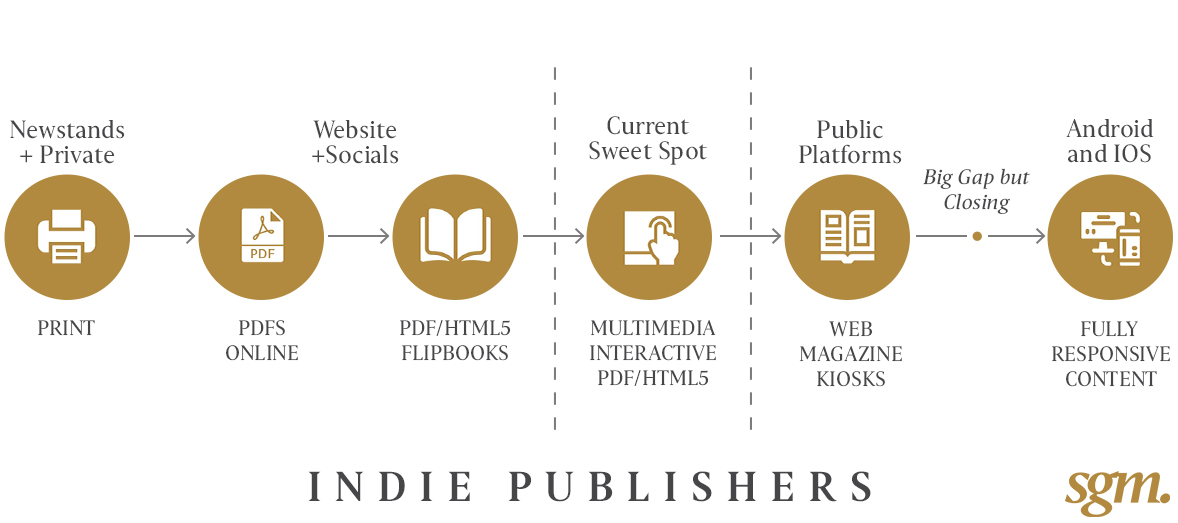Magazines are a unique way to put your branded content out into the world. The magazine business has been evolving from print to digital over the past decade and much has been said about the decline in print publications and the meteoric rise of content being made available online – free and via subscription.
So how does that relate to your opportunity to get your own personal or business magazine?
The good news is – you have plenty of options open to you.

1. PrintLet’s start at Print magazines- we know what they are. We have all bought one from a newsstand or perhaps picked one up in the reception area waiting for our accountant or doctor looking for something interesting to read.
We are now seeing an increase in free print magazines in all major supermarkets and hardware stores for example, as the recognition increases for magazines as a way to successfully increase customer engagement. The advent of private publishing i.e publish directly to your customers, is not new either, and has some specific use cases where ‘print works best’.
Magalogs (meaning a combination of a magazine and a catalog) has been around for some time as another form of print magazine for business owners as well.
2. PDFs OnlineMost magazine design outputs as a PDF format. There are other formats but the most common is a PDF. The ability to attach that PDF to emails or click to download as a lead magnet is incredibly common and easy to do. The upside is that it is a super simple process, the downside is that PDFs are not particularly friendly to read on mobile devices.
3. PDF/HTML5 FlipbooksAn extension to the humble PDF is to turn it into a flipbook or magazine format, showing dual pages at once, either with a ‘page turning’ feature or a swipe feature on mobile devices. This is a nice add on to the reading experience as it has the feel of ‘flicking through a magazine’ mimicking the behavior we show when we have a magazine in our hand. Anyone with a website today can access a wide range of free plugins that will take your humble PDF and turn it into a flipbook in just a few simple steps. Easy!
4. Multimedia Interactive PDFs/ HTML5Here’s where the fun starts and you can start to create interactive experiences with your audience, limited only to your imagination. The technology is readily available – it’s just a matter of doing your research and choosing the best software (free or paid) to use for your needs. So we’re talking about embedding video, audio, and links back to your website or landing pages right from the pages in your magazine.
For an e-commerce business, authors, coaches, consultants and any business selling online, this means that the browsing is done when viewing your magazine, with the ability for the customer to click a link taking them straight to your shopping cart – just as the big players in magazines are already doing. The simplicity of social sharing also becomes available to you, by embedding your social accounts into your magazine page, enabling a quick click through to your preferred channels. Just to get you really thinking about how you could create a unique customer experience in your magazine, National Geographic will be (maybe already has by now) adding virtual reality into their magazines to take you right into the landscape of the location you are reading about on the page. I wonder if you will feel the temperature change too if you are viewing a page all about the Antarctic. Cool stuff!
5. Web KiosksThere are many public platforms now that offer a free publishing service to get your magazine out into the world.
Another feature available is to have your own web kiosk for your magazines, displayed like a newsstand on your website and in formats that easily allow for both free content and content made available by subscription.
This is most relevant where the intention is to have multiple magazines published or multiple editions of the same magazine that will build up over time. The subscription model is relatively straightforward to set up, the challenges lie fair and square in the ‘art of marketing’ to build followers and sell your subscriptions to create recurring income.
There are many examples of indie publishers successfully creating subscription-based magazine businesses using paywalls and the creation of magazine libraries, where customers get access to substantial back catalogues of content for a monthly subscription.
6. Fully Responsive ContentSo where we are all heading is to be able to view all content across any device, where it is fully responsive to the device you are using. The birth of the magazine app has started and there are a number of starts up and established media organizations using this technology already.What this means is you can have your own native app, branded to your content available on AppStore and Google Play today.
The advantage is your example 4-page article on the ‘Top 5 Tips For Gardening In The Rain’ converts to a one-page vertical scrolling action where the content is relayed according to the size of your screen, making it a super enjoyable experience to read.
The downside is that most of us don’t want to become software or tech companies and are reliant on developers to crack the code on the most affordable and easiest ways for us to become early adopters and build the knowledge bank. It won’t be long though when this becomes the new normal for viewing magazine content online.
So, where are you on this pipeline?
Ali Fowler – Creator, Something Good

